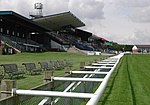Longcroft School
1948 establishments in EnglandCommunity schools in the East Riding of YorkshireEducational institutions established in 1948MolescroftSecondary schools in the East Riding of Yorkshire ... and 1 more
Use British English from July 2019
Longcroft School and Sixth Form College is a community secondary school situated in Molescroft, East Riding of Yorkshire, England. Its catchment area covers the north of Beverley, Leconfield, Swinemoor and Molescroft and has a capacity of around 1,500 pupils, including the Sixth Form.
Excerpt from the Wikipedia article Longcroft School (License: CC BY-SA 3.0, Authors).Longcroft School
Burton Road,
Geographical coordinates (GPS) Address Phone number Website Nearby Places Show on map
Geographical coordinates (GPS)
| Latitude | Longitude |
|---|---|
| N 53.850555555556 ° | E -0.44805555555556 ° |
Address
Longcroft School and Sixth Form College
Burton Road
HU17 7EJ , Molescroft
England, United Kingdom
Open on Google Maps









